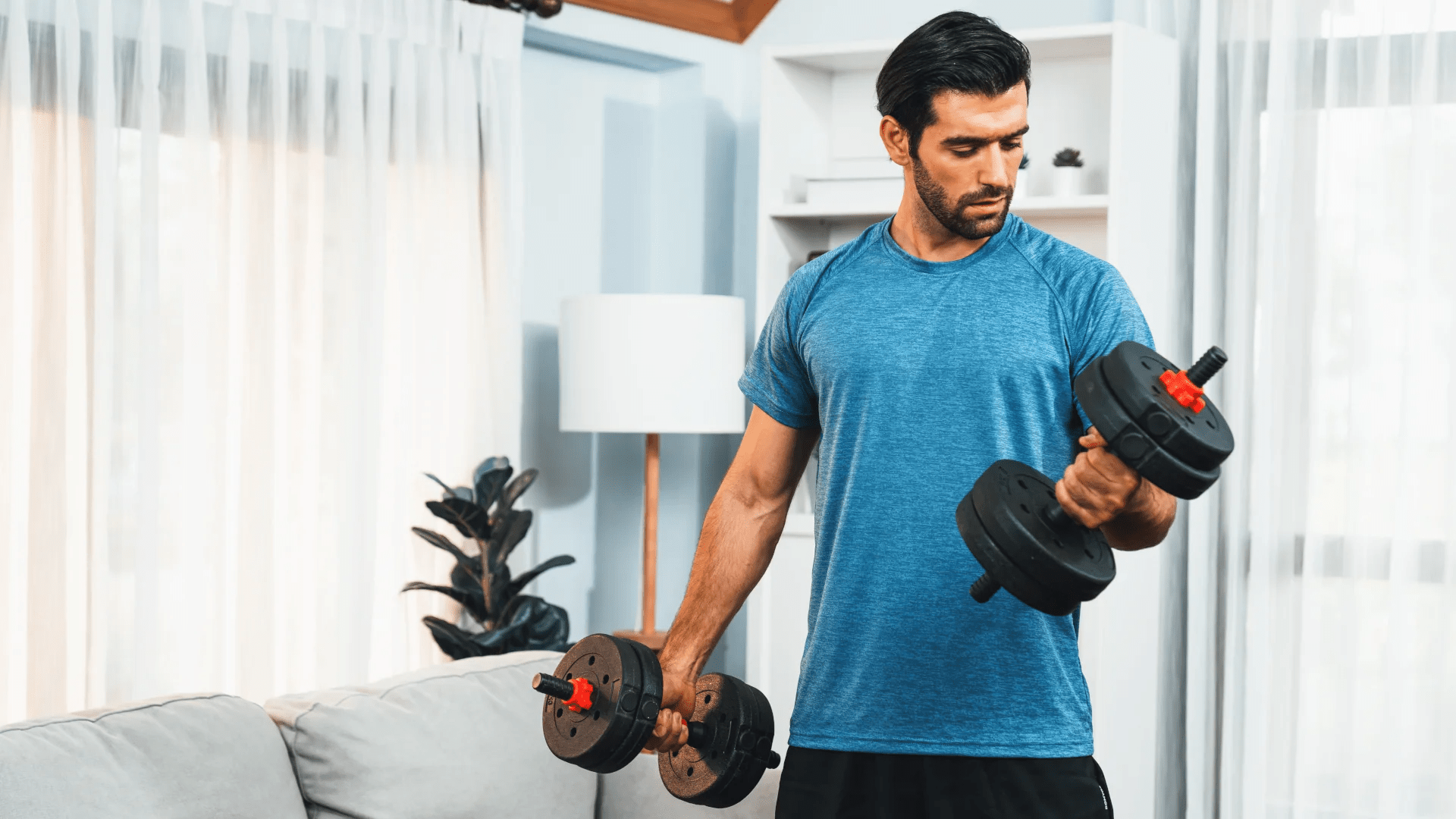Grab your cheat sheet |
Testosterone is pretty incredible and performs lots of essential bodily functions throughout our lives—from start to finish.
It’s essential in hair growth, cell production, bone and muscle strength, sex drive, and sperm production. Yeah, it’s pretty powerful stuff—but it doesn’t always stick around.
Middle-aged men, in particular, usually see a big dip in their testosterone levels. The truth is: our testosterone levels will drop as we get older, at around 1% each year from age 30.
Low testosterone levels can lead to a lower sex drive, a loss of muscle mass, tiredness, insomnia, a loss of hair, a lack of energy, depression, lack of focus and mood swings.
You might also find it tough to build muscle through continuous training because your muscle tissue can take longer to repair and build. This is a lot to think about, but it’s not just ageing that can cause a drop in your t levels.
Major causes of low t levels
Being overweight is a significant factor in a decline in hormone levels. These are also common causes of low testosterone:

Read: ‘What are normal testosterone levels?’ for insider advice on ‘where your t should be.’
Level up your t levels with high intensity interval training (HIIT)
Those who allow their t levels to drop tend to be those who aren’t worried about it, even though they probably should be. Those who are happy to “let themselves go.”
The good news is, there are ways to get your testosterone levels back up again—and it’s easier than you might think. Enter HIIT.
HIIT—or high intensity interval training—is a quick and easy way to boost your testosterone levels through exercise. Not only can you get your ‘T where it needs to be’, but you’ll also build muscle and get shredded in the process.
Interested? Let’s look at the concept of HIIT training and how you can use it to increase testosterone levels.
So, what is HIIT?
HIIT training involves short bursts of intense exercise followed by low-intensity recovery periods, rather than steady-state endurance exercises.

This intense yet satisfying activity usually lasts up to a maximum of 30 minutes—and it’s an efficient and time-saving way to raise fitness levels.
Types of high-intensity interval training exercises include:
A high-intensity interval training exercise based around running would involve all-out short sprints of around 20 to 30 seconds, followed by a recovery period where the heart rate can return to normal before performing the next rep.
You must put maximum effort into each rep to ensure you get the high-intensity benefit. Depending on your current fitness level, you should try around three to six rip-roaring reps per session for the best results.
Did you know? Studies show that high-intensity interval training is often more beneficial than long, drawn-out periods of exercise.
Does HIIT increase testosterone levels?
Studies show that regular high-intensity interval training exercises can raise testosterone levels.
Reps of exercising for short periods while giving it 100% maximum effort has been seen to increase t levels in men. Exercise is generally associated with raising t levels, but some are more effective than others, and none appear as effective as high-intensity interval training.
In fact, studies dating back to the 1980s have discovered that men performing exercises such as weight lifting and sprinting have shown significant increases in testosterone levels.
Other benefits of HIIT
HIIT isn’t just about testosterone (although it is a huge plus point). High intensity workouts offer many other health benefits, too. Let’s take a quick look:
Read: ‘Could you pass the Navy SEAL fitness test?’ for a cardio-pumping, muscle-boosting challenge.
The Best HIIT workout for higher testosterone levels
As a general rule of thumb, not all exercises can raise t levels in quite the same way as HIIT training. But, there are certain types of high-intensity interval training exercises that can do the job better than others.
Each HIIT exercise should last between 30 minutes and an hour, but how long your session will depend on your fitness level.
These exercises are named high intensity for a reason. If you’re in any doubt as to whether you’ll be able to cope with the demands HIIT places on your body, you should chat to a medical professional first.
Resistance training
Resistance training exercises like weight training are perfect examples of high-intensity interval training workouts that hit the spot when boosting t levels. Resistance exercises, where you’re performing quick, intense reps, are excellent and have been shown to boost both short-term and long-term t levels.
Performing a resistance exercise has been shown to increase t levels almost instantly and over the long term. Testosterone production during resistance training seems much higher in men than women.
Sprinting
Sprint interval training—running flat out for short periods (make sure you bring a big bottle of water to your training session)—is proven to raise testosterone levels in a big way.
A study found that 90 seconds of intense treadmill running interspersed with 90-second recovery periods boosted testosterone levels higher than just running for 45 minutes straight.
So, adding sprint interval training to your workouts is a great way to boost your t levels.
Cycling
Jumping on your bike and smashing out a series of quick reps of one or two minutes with the same recovery time is one of the best high-intensity interval sessions you can perform.

It’s essential to get the heart rate up and give it everything you’ve got, and cycling is a brilliant way to achieve this and build the lactic acid up, too.
How else can you boost t levels?
In addition to interval training, there are many natural ways to boost your testosterone levels—and it doesn’t have to be hard work.
These tried-and-tested methods all have a common theme—looking after your body. Let’s take a look.
Watch what you eat
Maintaining a healthy diet is a no-brainer when it comes to ensuring your health doesn’t decline—but certain foods can actively help increase your t levels.
Leafy green vegetables, onions, ginger, fatty fish, pomegranates—and oysters—have all been shown to help with testosterone. Try to eat a decent amount of vitamins and minerals, too, but avoid processed meats, sugar and alcohol wherever you can.
You need to have enough energy to function, as a reduced energy intake will have a negative effect, so make sure you take in the protein alongside plenty of healthy carbs.
Read: Our essential guide to 20 foods that boost testosterone for tip top T-boosting diet tips.
Sleep well
The usual rule of eight hours minimum sleep applies here, and getting a restful night is essential for many reasons.
Not least, because if you feel lethargic during the day, you’ll be less active, and your stress levels will probably rise—two big factors when it comes to low t levels.
Try to go to sleep at a regular time each night. Keep your room dark and free of distractions (yes, this will include muting your mobile phone). Getting plenty of sleep is essential for your mental health, too.
Keep an eye on your weight
One of the main culprits in testosterone decreases is excess body fat. Keeping on top of your weight and body mass means combining exercise with the correct food choices.
Keeping an eye on your weight will also improve your body composition and give you the mental and physical energy needed to function.
If you feel your body weight is high or need to lose weight and start a weight loss journey, do it sooner rather than later.
Physical exercise is essential
Physical fitness is essential if you want to increase testosterone levels. Physically active men tend to have higher testosterone levels than those who don’t undertake regular exercise.
A lack of movement goes hand-in-hand with T level decline—and if we picture a person who has let go of their health, we often think of someone simply sitting on a sofa, watching TV, and snacking. This is the exact opposite of what we want to achieve. By all means, watch TV and relax, but it’s crucial to get active so that your body doesn’t get adjusted to a sedentary lifestyle. Otherwise, it may feel like you don’t need testosterone. Physical activity is essential, and high training will boost things even further.
Reduce your stress levels
This is easier said than done, as so many of us are rushed off our feet, trying to make it from A to B each day while negotiating life’s obstacles.
Getting a decent night’s sleep is a great help, as we’ve mentioned. Still, there are other things you can do to get stress levels down like improving your time management, taking more breaks (even short ones to ‘catch your breath’), spending more time with friends, and taking some ‘me’ time each day.
Running yourself into the ground is a sure way to see your t levels drop—so try to slow down the pace of life a little where you can.
Hormone replacement therapy
In addition to the natural T-boosting methods we’ve talked about, you can also increase testosterone levels through medication via hormone replacement therapy.
This is, however, only usually available for men with deficient T levels and after a lengthy discussion with a medical professional.
There’s also no clear evidence that hormone replacement therapy will benefit men whose testosterone levels are through natural decline (usually due to ageing).
Also, HRT has been shown to produce many unpleasant side effects like:
Not good. Needless to say, this is a high-risk method with the potential of little or no return and where you could potentially end up in a worse state of health than where you started. Further research is needed with regard to HRT to see if the pros can outweigh the cons.
Boost your t levels the right way
There’s no denying the natural ways to boost testosterone levels are the best. Keep your mind and body healthy to send the message to your body and brain that you aren’t ready to give in to natural decline at any time soon.
Not all exercise is the same, and HIIT training is the perfect exercise session you can perform to help get testosterone levels higher.
Heavy resistance exercise, weight loss, training volume, and watching what you eat are vital factors in increasing testosterone.
Adding a high-intensity interval training session or two to your weekly exercise routine will affect your t levels in a positive way. A good old, heart-pumping HIIT session certainly has plenty of benefits beyond raising testosterone levels. Pick a HIIT style that suits you, and you’ll reap the T-boosting rewards you deserve in no time.
- Read: 9 testosterone-boosting exercises you should try for more epic training tips.
Try TestoPrime
TestoPrime is an all-in-one testosterone booster. An all-natural testosterone support that can help any man take control of his youthful vitality with a flood of new and natural testosterone.
It will help you build muscle, increase physical and mental energy, support protein synthesis, burn body fat, and improve your mood and confidence. Add TestoPrime to your HIIT training program and you’ll be unstoppable.





